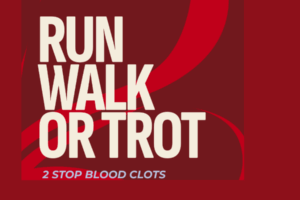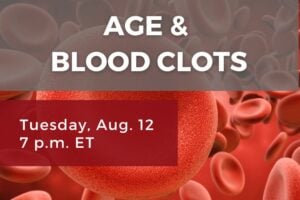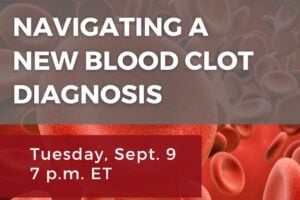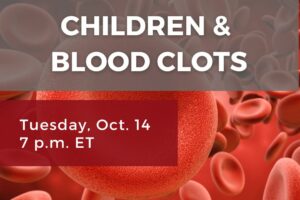Written by Elizabeth Varga, MS, CGC (Genetic Counselor at Nationwide Children’s Hospital; NBCA Medical and Scientific Advisory Board Member)
On March 18th, 64 healthcare providers gathered at Nationwide Children’s Hospital in Columbus, OH for a free symposium on pediatric venous thromboembolism in acute and chronic illness.
Dr. Uma Athale, MD, M.Scl, FRCPS from McMaster Children’s Hospital in Hamilton, Ontario, Canada kicked off the symposium with her talk on “Thrombosis in Children with Cancer.” Although venous blood clots are thought to be uncommon in pediatric patients, one study showed that there has been a 70% increase in the number of cases of VTE in hospitalized children between 2001-2007, from 34/10,000 to 58/10,000 (1). Children with VTE tended to have longer hospital stays and had more underlying chronic medical problems than those without VTE (1). Cancer is known to increase the risk of VTE in both adults and children. In a study published by Dr. Athale, researchers at McMaster’s Children’s Hospital found that 57/726 (8%) of pediatric cancer patients had VTE. VTE was more commonly identified in patients with central venous lines; who had certain types of cancers, including acute lymphoblastic leukemia, lymphoma and sarcoma; in older patients (≥10 years); and among those who used certain chemotherapeutic agents. At least one study has investigated the use of risk models to identify high-risk children for whom anticoagulant treatment might be warranted for VTE prevention (3). More clinical trials are needed to assess the safety and effectiveness of anticoagulant treatment to prevent and treat VTE in pediatric cancer patients.
Dr. Sarah O’Brien, MD from Nationwide Children’s Hospital in Columbus, OH covered a “hot topic” of venous thromboembolism and hormonal contraception. On average, combined oral contraceptives, which contain both estrogen and progestin, increase the risk of VTE 2- to 6- fold in users versus non-users. The World Health Organization (WHO) recommends that women with a history of thrombosis, women with first-degree relatives with DVT/PE, and women with a known thrombophilia avoid the use of combined hormonal contraceptives. Some options that may be appropriate for women with these conditions include progestin-only oral contraceptives, contraceptive implants, progestin-releasing intrauterine devices (IUDs), and non-hormonal IUDs. The advantages and disadvantages of each option were presented.
Dr. Bryce Kerlin, MD from Nationwide Children’s Hospital in Columbus, OH, reviewed the association between a kidney condition called nephrotic syndrome and VTE. Approximately 3% of all children with nephrotic syndrome develop VTE, however, in patients with severe forms (congenital, secondary and those with membranous histology nephrotic syndrome) the risk ranges from 10-25%. Nephrotic syndrome may increase VTE risk because pro-blood clotting factors are increased in the circulation, while anti-clotting factors are decreased. Research is underway to identify other biomarkers that may aid in risk prediction. Ultimately, the goal is to identify highest risk patients, so that anticoagulation may be instituted for prevention.
Dr. Vincent Faustino from Yale School of Medicine in New Haven, CT presented on “Venous Thromboembolism in Critically Ill Children.” He presented compelling data showing the disparate practices of ICUs when it comes to anticoagulation in the critically ill; some centers almost never use prophylactic treatment, while others use prophylaxis in as many as 20-30% of patients. Many critically ill children have more than one known risk factor for VTE, including the presence of a central venous line and/or ventilator. There is a need for randomized-controlled pediatric trials to demonstrate safety and effectiveness of anticoagulants in pediatric ICUs for blood clot prevention.
Dr. Shannon Carpenter, MD, MS, FAAP from Children’s Mercy Hospital and Clinics in Kansas City, KS reviewed the association between infectious disease and risk of thrombosis. Several registry studies from Canada, the United Kingdom, Germany and the Netherlands have demonstrated that infection is an underlying risk factor in a large percentage of pediatric VTE patients (5). Certain bacterial or viral infections, including antibiotic-resistant Staphylococcus aureus (e.g. MRSA), Fusobacterium, or Varicella zoster, may induce greater risk of VTE. Research is needed to assess whether or not patients with these infections should receive prophylactic anticoagulation treatment, and if so, what is the best therapy and dosage.
Dr. Gordan Mack, MD from University of Utah in Salt Lake City, UT examined the high incidence of VTE in children with cardiac disease. VTE occurs in up to 18% of patients with congenital heart disease who are discharged from the hospital (6). This has to do with the significant proportion of patients with congenital heart disease who require surgery, central venous lines, prolonged intensive care, transplant and ventilator support. Anticoagulation management is difficult in this context, however, advances in extracorporeal life support (ECLS/ECMO) have led to extensive knowledge gains in this area, which will hopefully improve care.
In summary, although VTE is less common in children than adults, the incidence of VTE is increasing in children and may be a life-threatening complication. This symposium highlighted this problem and current scientific methods intended to address it. Nationwide Children’s intends to host such a conference highlighting scientific advances in the field of pediatric VTE once every two years.
1. Raffini et al. Pediatrics 2009; 124:1001-8.
2. Athale et al. Pediatr Blood Cancer 2008; 51:792.
Click here to review the signs and symptoms of DVT/PE.






